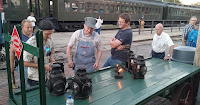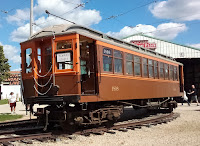...to the 13th Annual Steam Department Benefit! This is a unique and unforgettable event at a stunning venue, plus the proceeds go to help steam restoration and maintenance at IRM, of course. Click here for more info and to purchase tickets.
News and views of progress at the Illinois Railway Museum
Thursday, September 26, 2024
Wednesday, September 25, 2024
We Come Bearing News
It took about a year, but the brass foundry has just completed the three sets of motor bearings we need to finish replacing the ones on the 309's #1 truck. They've already been delivered to the machine shop that will be doing the necessary machining, the same place that did the first one. The first one was installed earlier this year and tested; it runs fine, not measurably hotter than the old ones.
Posted by
Randall Hicks
at
5:00 PM
0
comments
![]()
Tuesday, September 24, 2024
Vermilion and Ivory
Frank writes...
In other news, the center and west portions of the car shop were cleaned out for Arnfest, which is happening next weekend. This resulted in the palletized items shown here being moved out into the new Barn 4 extension. Thanks to Nick and Greg for working with me to move some spare parts around. Hey, anyone have 2x4's they don't need? We could use them to build heavy-duty shelves. Inquire within!
And Bus Day was over, but Richard and Joel showed me the above "punch card," which I thought was a nifty idea. I guess they've been doing this for a couple of years, but I am rarely out on Saturdays so I hadn't encountered it before.
Posted by
Frank Hicks
at
12:00 PM
2
comments
![]()
Labels: Shaker Heights 63
Monday, September 23, 2024
Bill Wulfert's Bus Day Bash
Luckily, I have friends who can usually provide pictures of anything I missed -- in this case, Bus Day!
So thanks, Bill!
Posted by
Randall Hicks
at
4:51 PM
5
comments
![]()
Labels: Bill Wulfert Photos
Sunday, September 22, 2024
Saturday Snapshot
Operations on Saturday went well. I was the motorman on the 309-319, and was too busy to get many pictures, so you'll have to be satisfied with these three. The 1630 was pulling the heavyweight coach train as usual, a real crowd pleaser.
Posted by
Randall Hicks
at
12:08 PM
3
comments
![]()
Thursday, September 19, 2024
More 277 Progress
Gregg Wolfersheim sends us some more pictures of his impressive work on the interior of the 277:
 |
| The combine's baggage compartment looking to the rear. About 95% done. |
 |
| Looking towards the front. |
 |
| The divider door getting painted. |
Posted by
Randall Hicks
at
1:15 PM
1 comments
![]()
Labels: 277 Progress
Sunday, September 15, 2024
A Good Time Had by All
Frank writes...
In the meantime, Zach had gotten Veracruz 19 dug out of Barn 7, and we took it out for night operations. The above crew photo was taken by Jordan Torregrosa. Zach and I are both wearing the new reproduction CSL badges that he had made earlier this year. They look fantastic and I got a number of compliments on mine. The good news is that you can still purchase one! A few extras were made and are now available. Drop us a line if you're interested.
Thumbs up! This was going to be a photo of a nice sunset, but it was photobombed by some derelicts from the Diesel Department. L-R Matthew K, James K, Logan S, Lee E, and Zach.
Here's the 19 at Depot Street. We ran until after 11:00pm (!!) and were remarkably well patronized the entire time. Who doesn't like an open car on a warm evening?
There are always unusual train operations on Showcase Weekend; Saturday highlights this year included the Zephyr as well as the Pullman consist pulled by AT&SF 92 and the 1630 (not at the same time!), plus IT 101 running at night. A very unusual piece to see on the railroad was Milwaukee Electric dump motor D13, which carried passengers in the dump section for the first time in at least 15 years, maybe more. Nathan and Mikey set up portable stairs at Central Avenue and ran express trips around the streetcar line from there. This operation was extremely popular, but unfortunately, after a few trips the car blew a control resistor and had to go out of service. It's not a serious problem, though, and it's probably already fixed by the time I'm writing this.
Posted by
Frank Hicks
at
9:53 PM
4
comments
![]()
Labels: 18 Operation
Friday, September 13, 2024
Old Reliables
Yesterday, when I was lubricating the journals on the 319, it struck me that I had been dealing with those particular trucks for a long time. Here's a picture of the first train of cars to arrive on IRM property, on the first track to be laid, in May of 1964. There are three CA&E cars: 321, 431, 309, and four L cars: 1024, 1268, 1797, and 1808.
 |
| Mizerocki collection |
Posted by
Randall Hicks
at
6:57 PM
1 comments
![]()
Ready for Showcase
Showcase Weekend, known as Member's Day in ancient times, is almost here, and we need to be ready! There will be a large assortment of interesting equipment in operation, as always. Among them will be the 309 and 319, so I checked and filled the oil in the compressors and journal boxes. That's a dirty and annoying job to have to do in the morning of operations. Now all is well.
Posted by
Randall Hicks
at
9:31 AM
0
comments
![]()
Tuesday, September 10, 2024
In Memoriam Doug Oaks
Once again we must sadly post notice of the death of another long-time IRM member, Doug Oaks. I remember him mostly from back in the 70's, when he was one of the earlier trolley bus fans. In later years he lived too far away to appear very often, but kept in close contact with the Museum. And he was always a strong supporter of all the various projects on the property, and a good friend to everyone who knew him.
The funeral will be next Monday, Sept. 16 in Ohio. The obituary is at this link. Thanks to Richard Schauer for bringing this to our attention.
Posted by
Randall Hicks
at
7:26 PM
1 comments
![]()
Monday, September 9, 2024
277 Progress Report
Another dramatic submission from Gregg Wolfersheim:
 |
The right side of the combine is coming together. Most of the painting is done. Baggage rack is back up. |
 |
The lower wall area is getting transformed too. |
Posted by
Randall Hicks
at
9:26 AM
1 comments
![]()
Labels: 277 Progress
Saturday, September 7, 2024
Light on the Motors: A Single-Trucker Comes to Grief
This close-up view of the end platform of the car shows the GE K-10 controller (moderate-capacity equipment, used on 2- or 4-motor cars up to a total of 160 hp) and the brake wheel on the end platform of the car. You can also see how the angle-iron bumper construction is suspended out from the car’s platform sills. The wheel-type hand brake is a bit unusual for a hand-braked car; gooseneck handles were more common. Just to be clear, the “Little Rock” reading is the line within Fort Smith on which the car was working; this was not an interurban trip to the state capital (one-way distance = 161 miles!). The poster advertises a "tent show" starring Rentfrow's Jolly Pathfinders, at one point advertised to be "the top traveling tent show in the country," at - where else - Electric Park.
Posted by
Frank Hicks
at
9:00 AM
0
comments
![]()
Labels: Krambles-Peterson Archive
Tuesday, September 3, 2024
More from the Weekend
More pictures from Labor Day Weekend: First of all, a couple showing how we light the kerosene marker lamps on the CA&E cars:
And then, the 1808 in operation. It was pulled out of the barn so the 1268 could get its roof washed and repainted. Then it moved over to 43 temporarily.
Posted by
Randall Hicks
at
3:04 PM
0
comments
![]()















































